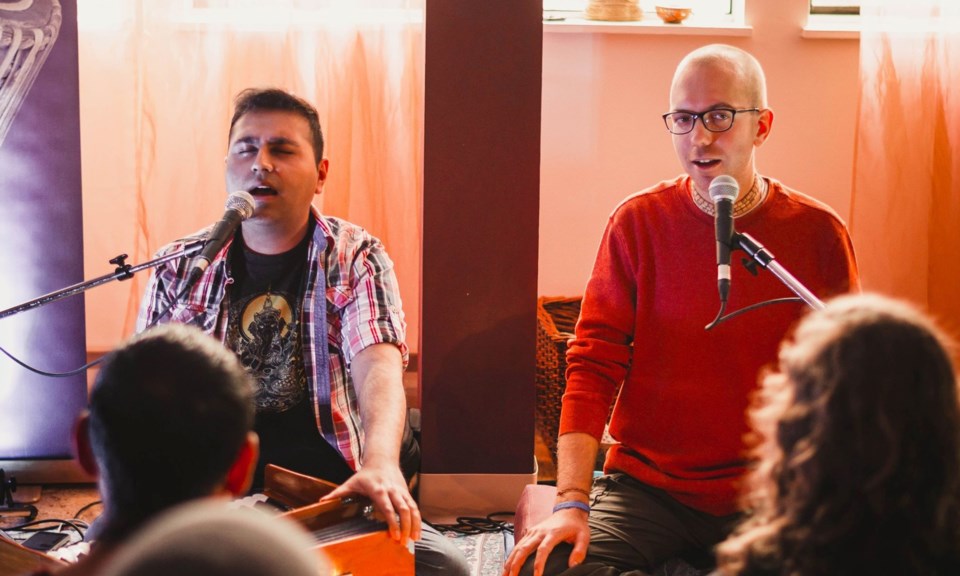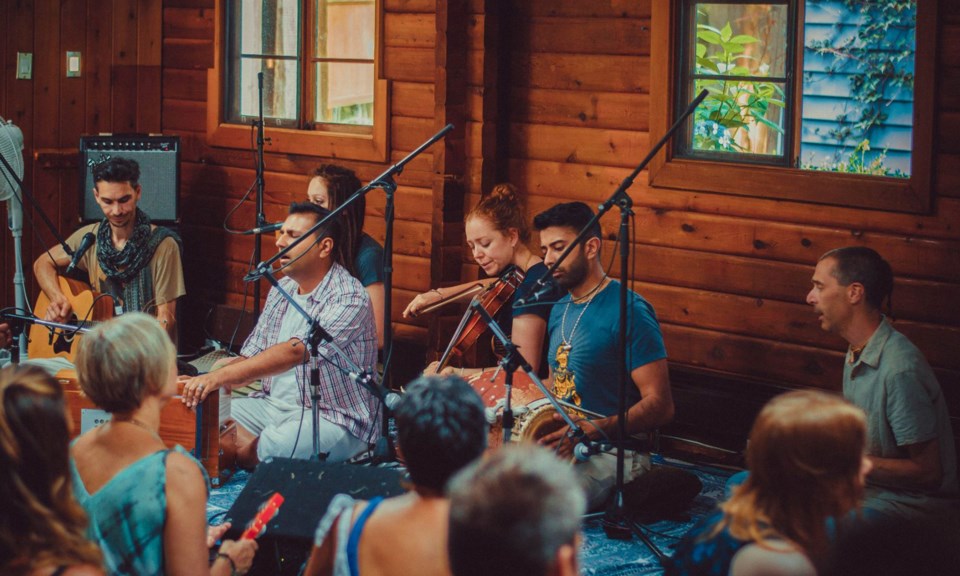Welcome to Leap of Faith, a weekly blog hosted by veteran religion reporter Alicia Ambrosio, exploring faith, spirituality and Vancouver's sacred spaces.Ìý
Itâs Saturday night on Commercial Drive and Iâm bumping elbows in a room full of locals out for the evening. There is a faint scent of spice and incense in the air and a quiet buzz in the room. I am not, however, at one of the Driveâs popular restaurants for dinner.
Instead Iâm sitting crosslegged on the floor of , sipping hot chai along with a few dozen other people waiting to move into the studio space for this eveningâs Kirtan session.
Kirtan is a sanskrit word. It means to narrate or recite. In practice, it is a call-and-response style of singing or chanting. Both the Hindu and Sikh religious traditions use the call-and-response style to praise God. Bhakti Yoga â known as the yoga of devotion â employs Kirtan as a form of chanting meditation and a way to be close to the divine.
Kirtan Â鶹´«Ã½Ó³»hosts bi-weekly Kirtan sessions called at Unity Yoga Teahouse.Ìý
In the studio space where the session takes places, yoga blocks and bolsters are arranged around the room in a semicircle to be used as seating. My companion and I claim two remaining spots against the back wall and scan the room.
The average age of the group looks to be fairly young â 20s and 30s, though there are a handful of participants clearly over 50. And the crowd is diverse: There are women wearing flowing yoga wear and men in lumberjack shirts with distinctive beards. A few participants look like students who have just emerged from their books, and there are a couple of young men in khakis and button-up shirts.
Ìý

Kirtan Vancouverâs EnChant sessions are normally led by about four of its core team members. Tonight, however, is special: Swami B.A. Tirtha from the San Diego Ashram of the International Society for Krishna Consciousness (ISKON) is visiting. He will help lead tonightâs session and, between chants, offer a few thoughts to ponder.
Ani Kansal, one of the organizers, welcomes everyone and gives a brief explanation of what to expect before picking up the drum he will be playing and handing things over to a man who goes by the name Brihat. Brihat will be leading the first chant and playing the harmonium (a small pump organ). The words of the chant are projected on a screen next to the Kirtan musicians, and three mantras will be chanted during the two-hour session.
Soon the room is filled with a melodic chanting, accompanied by the unique sound of the harmonium, hand cymbals and drum. The melody starts slow and reflective, and, over about 20 minutes, builds to a frenzy before slowing again and trailing off.Ìý
The atmosphere is relaxed: everyone seems to have a cup of tea or a water bottle with them, and participants are free to wholeheartedly take part in the chanting, or just listen quietly. Some people sit in the lotus position with their eyes closed, others sway and raise their arms with the music. Some get up and quietly leave the room whenever they need to.
Chanting in Sanskrit is a little outside my comfort zone, so I just listen and hum along. After a few minutes I feel relaxed â though my back and legs are complaining about my seating arrangement.
In between chants, the SwamiÌý Tirtha takes a few moments to share some thoughts with participants. He references the Bhagavad-Gita â an ancient Indian text in which Krishna reveals himself to a warrior and lays out the main components of Karma yoga â but the few thoughts Tirtha shares could fit into any spiritual tradition.
Most of the 10 directors of Kirtan Â鶹´«Ã½Ó³»identify with the Bhakti Yoga tradition and see Kirtan as their spiritual practice, but they try to create a space where anyone of any religious tradition â or none at all â can get into chanting meditation.
Seated on the floor eating a light vegan meal after the session, Kansal explains the philosophy behind Kirtan Â鶹´«Ã½Ó³»with a quick Bhakti yoga history lesson: He says Kirtan used to be a practice restricted to certain castes of Hindus. About 550 years ago, a Kirtan practitioner named Sri Chaitanya began to feel that it was unfair to restrict the practice of Kirtan to a select few when there were so many people who could benefit from it. Chaitanya opened the practice of Kirtan to everyone and is considered a father figure for Bhakti yoga.Ìý
Ìý
Ìý
That is why Kirtan Vancouver, âis not restricted to a religion and is available for anyone to adopt in their daily practice if they want and we often help people with that,â Kansal says.Ìý
However, unlike many of the other Kirtan Â鶹´«Ã½Ó³»organizers, Kansal was exposed to the practice as a child. His grandfather first identified with the Bhakti yoga tradition in India and passed the practice on down the family tree. Kansalâs daughter is a fourth generation Bhakti practitioner.
Practising Kirtan and Bhakti yoga affect every aspect of Kasalâs life. He said it gives him a âbalanced consciousness, and because of that balance of spirituality, it helps [me] be balanced and grounded.â
But not everyone will feel inclined to embrace Bhakti yoga as their spiritual practice. He says some people come to a session, they enjoy it, they find they feel good after participating and they come back whenever they feel like it, âand thatâs great, weâre happy about thatâ he says. Others find something that resonates with them and decide to delve deeper into the practice of Bhakti yoga and Kirtan meditation.
Janeen Mills, a soft spoken 27 year old, was introduced to Bhakti yoga while taking her yoga teacher training. Her training offered âjust a snippetâ about Bhakti yoga, so when she saw on Facebook that a fellow student was attending a Kirtan Â鶹´«Ã½Ó³»session she came along out of sheer curiosity.
âI felt so welcomed,â she said of her first Kirtan experience. Yoga had already become a spiritual practice for Mills and Kirtan seemed to her like a natural extension of what she was already practising.
Mills said she went on a Bhakti retreat to learn more about the tradition and spirituality behind Kirtan. She said embracing the practice of Bhakti yoga had been transformative. âI never thought about the food I eat, my words, my thoughts. I learned that what I do affects others⦠I donât drink anymore, I stopped eating meat,â she explained. Mills also makes meditation a part of her daily routine, finding a quiet spot at work during her break. âIf I donât meditate, I feel it.â
Mills, who said she grew up with no religious background, added, âI never understood why people go to church, but now I do.âÌý
The Bhakti yoga tradition also promotes non-violence, and teaches that âfood also carries consciousness,â said Kansal. Those who have committed themselves to the practice of Bhakti yoga adopt veganism and look for ways to serve those around them. Every Kirtan Â鶹´«Ã½Ó³»session ends with a light, vegan meal served free of charge by volunteers. At least once a year, the group serves a free vegan meal and provides free yoga classes to people living in the Downtown Eastside.Ìý
⢠takes place every two weeks at Unity Yoga Teahouse. Doors open at 6 pm and admission is free, but donations are encouraged. also hosts a monthly Kirtan Session at One Yoga For the People (150 W. Hastings St.).Ìý
Ìý
⢠After graduating from Simon Fraser University with a degree in communication, Alicia moved to Rome, where she got an unexpected start covering religion. Stints in Toronto, Madrid and Toronto followed, culminating with her return home to the West Coast. Alicia has worked as a television producer and host, and is currently a freelance writer for Aleteia and Catholic News Service, as well as Leap of Faith, the Westender's blog on faith and spirituality in Vancouver.



